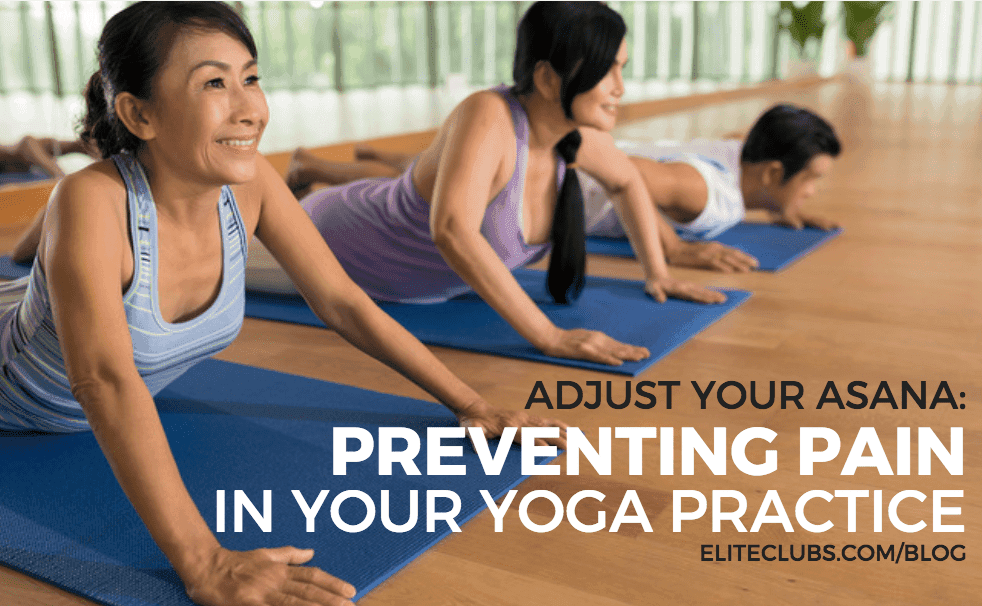
Last week we discussed how you can avoid injury and pain in yoga class. But some of those tips require asking your instructor for help or insight. So, this week let’s talk about a few things you can do to prevent pain in each asana until you are able to get the attention of your yoga instructor.
Do no harm – Ahimsa.
One of the foundational principles of yoga is really the best advice for each body. When you practice yoga err on the side of caution and safety. Go slowly, respect your body’s inner wisdom. If something hurts, don’t do it! If a pose becomes uncomfortable come out of it. The more you practice the more access you will have to your intuitive sense of what is right for your body as you are in your yoga practice!
Begin at the beginning.
Think an advanced class sounds right for you because you are super fit, catch on fast, and don’t really attend beginner anything? Big mistake! Beginner classes teach you the poses so you don’t have to figure them out on the fly. You wouldn’t learn to swim by showing up to participate in the Olympics, right? Give yourself the gift of a few basic classes to acclimate yourself to the yoga movement or asana (pronounced AH-sah-nah).
Be on time, begin with a warm up.
Those first few minutes of class make a difference. We use soft movements based on what body areas and asanas we will move into later in class, so a gentle pre-pose. Give yourself time to arrive a few minutes before class to take advantage of warm ups.
Gently increase strength in poses.
Students often push themselves to achieve an outer form of an asana. Don’t try to emulate the teacher, another student, or a picture of the pose you remember seeing.
It is important to move with balanced action, not just a strong foothold, but also with ease of breath and movement, as well as a soft jaw and face. Once you find ease in your poses consider deepening the pose until you meet resistance to that movement. Resistance to your poses usually comes from muscles that automatically and protectively contract or tighten to prevent injury.
Moving forcefully and quickly invites the muscular contraction that blocks you from deepening your pose and frustrates your mind! Slow and steady movements pave the way to progress in your practice.
When it comes to yoga and your practice, awareness is key.
Instead of tuning everything out and going through class on autopilot draw your attention to your body and your mat. Forget about the awesome asanas around you and notice how your body feels in your asana today.
Breathe, and notice that too. If you are making noise like the little engine that could, it is very likely you are working too hard! Soften your effort level until your breath is even and easy.
The bottom line.
Leave your preconceived notions outside the studio with your shoes and coat. What that really means is—no egos allowed! There will be others who are more flexible, more adept, more aware, softer, less resistant, and just plain better than you on your mat today. It’s ok, let it—allow it—to be ok.
You know that yoga is a practice and not a performance. So, keep coming back to your mat, be soft and patient with your body and your progress. Remember that sometimes progress is one step forward and two steps back. You are not the same today as you were the last time you came to your mat. Realize you are growing and changing just as your body is. Remember this and your mind and your body will be thankful that you do.
More on this subject to come! Subscribe to our email list so you don’t miss anything!
Subscribe to our Weekly Blog Digest
Written by Sue Dlugopolski, Certified Yoga Instructor (E-RYT 500 Hour) at Elite Sports Clubs
Sue Dlugopolski is certified in 500 Hour Yoga Therapy; 200 Hours each – Anusara Yoga & Vinyasa Yoga. Her additional certifications include: Relax & Renew Restorative Yoga Trainer, Therapeutic Restorative Yoga, Prenatal Yoga, Karma Kids Yoga, Kineselogy & Therapeutic Movement.
I encourage a balanced sense of strength and ease in participants. Continuing education in yoga anatomy and functional movement enables me to observe more clearly the changes in alignment participants require to move more freely. I teach Hatha, Restorative, & beginning yoga to help participants feel better in their bodies everyday.